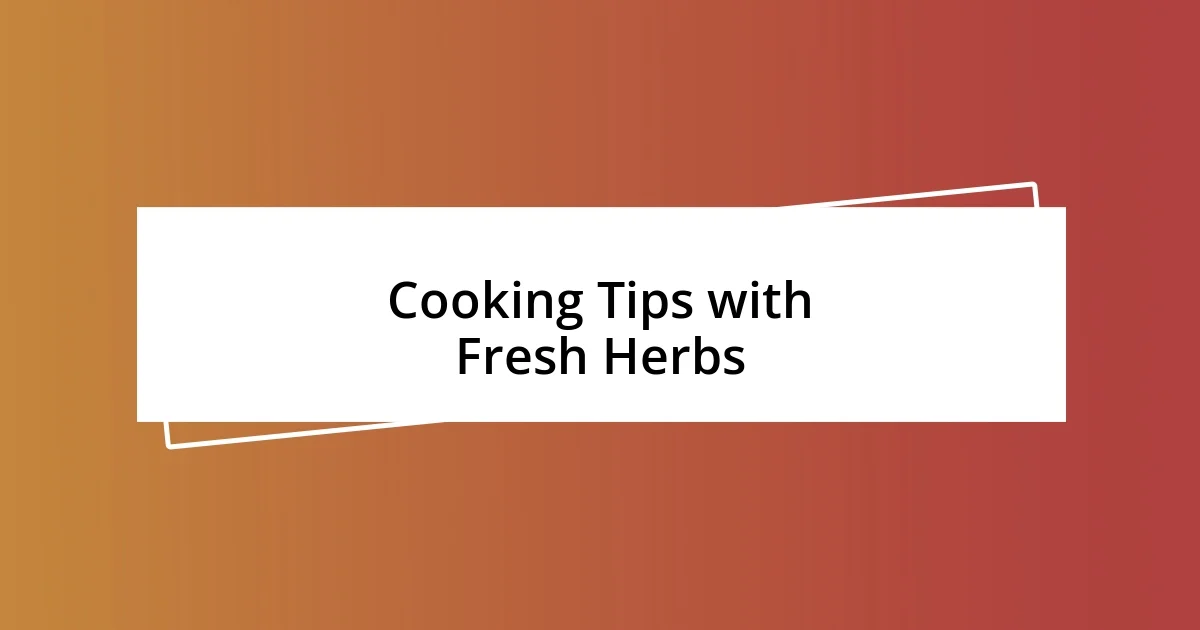Key takeaways:
- Fresh herbs enhance flavor and emotional connection in cooking, transforming ordinary dishes into extraordinary experiences.
- Selecting fresh herbs involves looking for vibrant colors, firmness, and strong aromas, contributing to the overall quality of meals.
- Creative techniques, such as bruising herbs and infusing them into dishes at different cooking stages, significantly elevate flavors and bring culinary joy.

Importance of Fresh Herbs
Fresh herbs hold a special place in my kitchen, not just for their vibrant flavors but also for their ability to elevate a dish from ordinary to extraordinary. Have you ever noticed how a sprinkle of fresh basil can transform a simple pasta into a taste of Italy? It’s incredible how just one ingredient can evoke such strong emotions and memories.
I remember the first time I tried cooking with fresh rosemary. The moment I crushed the leaves, a woody, fragrant aroma filled the air, transporting me back to my grandmother’s garden. Cooking with fresh herbs isn’t just about taste; it’s about connecting with nature and preserving the essence of food. Each herb brings its unique character, enhancing nutritional value while infusing love and care into every meal.
Thinking about health, using fresh herbs is a smart choice for anyone interested in wellness. They are packed with antioxidants and other beneficial compounds. Have you considered how adding fresh cilantro or parsley not only brightens up your dish but also enriches your body? This simple addition can make a real difference in both flavor and nutritional quality.

Selecting Fresh Herbs
Selecting fresh herbs can feel like a delightful adventure, one that completely alters the outcome of a dish. When I’m at the market, I can’t help but be drawn in by the vibrant colors and aromatic scents wafting through the air. There’s something about holding a sprig of mint or a handful of cilantro that instantly warms my heart, reminiscent of my travels to bustling local markets. When choosing herbs, I always make sure they look lively and fresh – vibrant greens without wilting or browning are key indicators of quality.
Here are a few tips I rely on when selecting fresh herbs:
- Look for Bright Colors: Fresh herbs should have vibrant colors that signal freshness.
- Check for Firmness: The leaves should be crisp, not limp or wilted, indicating they were recently harvested.
- Smell the Aroma: Give them a gentle squeeze; a strong fragrance suggests intense flavor potential.
- Consider Seasonal Availability: Certain herbs thrive in different seasons, so it’s wise to select those that are in season for better taste and quality.
Picking fresh herbs shouldn’t be a chore; it’s a chance to connect with ingredients that can elevate your cooking. I often remember a time I used freshly chopped dill from a local farmer’s market in a yogurt dip. It was like tasting summer itself. That’s why, for me, selecting the right herbs is not just about cooking; it’s an exploration of flavor and seasonality that enriches every meal.

Common Fresh Herbs to Use
Common fresh herbs can transform your meals, and I find it interesting how each one brings its distinct flavor and spirit to the table. Take basil, for example. I remember a summer afternoon when I picked fresh basil from my patio garden and added it to a caprese salad. The sweet, slightly peppery flavor was so much more vibrant than the dried stuff I used to reach for! Similarly, thyme’s earthy notes remind me of my first attempt at roasting chicken, where a handful of this herb turned an ordinary dinner into a delicious, succulent feast.
When it comes to versatility, parsley is another go-to in my kitchen. I’ve used it in everything from salad dressings to garnishes, and its fresh brightness never fails to elevate a dish. I recall one particular dinner party where I added a sprinkle of parsley over a rich, creamy risotto. The guests raved about the contrast it created—showing how fresh herbs can truly elevate a dish. Another favorite of mine is cilantro; it brings such a zesty twist to salsas and curries. Have you ever drizzled fresh cilantro over a warm bowl of pho? It makes the experience so much richer and more memorable.
Exploring the unique profiles of these common fresh herbs can be quite rewarding. I’ve found that using them in tandem can create remarkable flavor combinations. For instance, my love for Mediterranean cuisine often leads me to pair oregano and rosemary, enhancing the aroma of roasted vegetables and meats. Each herb plays a part, inviting layers of taste while reminding me of shared meals with friends and family around a table.
| Herb | Flavor Profile |
|---|---|
| Basil | Sweet, slightly peppery |
| Thyme | Earthy, warm |
| Parsley | Fresh, bright |
| Cilantro | Zesty, citrusy |
| Oregano | Robust, slightly bitter |
| Rosemary | Woodsy, pine-like |

Techniques for Using Herbs
Utilizing fresh herbs involves a bit of creativity and instinct, which I absolutely love. One technique that has become a ritual for me is gently bruising the leaves before adding them to a dish. This simple act activates the oils and intensifies their aroma. I remember preparing a lemon-herb chicken on a cozy Sunday afternoon; I crushed the rosemary and thyme between my fingers before mixing them with olive oil. The smell that filled my kitchen was heavenly—it turned an ordinary meal into something special.
Another technique I cherish is incorporating herbs at different cooking stages. For instance, adding chopped parsley at the very end of a dish perks up the flavors beautifully, creating that burst of freshness that I crave. Have you ever seasoned your pasta with fresh basil right before serving? The taste is elevated tenfold! I can still picture a delightful evening spent with friends over bowls of spaghetti tossed in olive oil, garlic, and just-picked basil. It’s moments like that where the technique truly transforms the dining experience.
Lastly, I like to infuse herbs into oils and sauces. I often prepare a fragrant herb oil by blending fresh herbs with olive oil, then letting it steep. This technique not only preserves their vibrant flavor but also adds depth to any dish. The first time I drizzled my homemade herb oil over grilled vegetables, my taste buds were dancing—it was a game-changer. So, what’s stopping you from experimenting with these techniques? Embracing fresh herbs can be a joyful adventure for your palate!

Storing Fresh Herbs Properly
Storing fresh herbs properly is essential to making the most of their vibrant flavors. I’ve found that treating them like delicate flowers works wonders. For softer herbs like basil and cilantro, placing them in a glass of water and covering them loosely with a plastic bag can extend their freshness for several days. It reminds me of how my grandmother always kept a little jar of basil by the kitchen window, and it felt so alive, never fading away.
On the other hand, sturdier herbs like rosemary or thyme benefit from being wrapped in a damp paper towel and stored in the refrigerator. The first time I tried this method, I was astonished at how fresh they remained even after a week. Have you ever reached for a sprig of dried rosemary and realized it just didn’t have the same zing? It’s such a letdown, but proper storage can keep that herb’s aroma intact, adding excitement to my cooking.
Lastly, I’ve learned that freezing herbs can be a game changer. When I first discovered this technique, I chopped up excess parsley and mixed it with olive oil before pouring it into an ice cube tray. The moment I dropped one of those cubes into my soup on a chilly evening, the fresh flavor burst forth like a warm hug. It’s little strategies like this that not only save time but also extend the joy of cooking with fresh herbs past their prime. Trust me, once you’ve tried it, you’ll wonder how you ever cooked without that vibrant touch of home.

Cooking Tips with Fresh Herbs
When it comes to cooking with fresh herbs, I often recommend starting small. Just a pinch of finely chopped herbs can elevate a simple dish to restaurant quality. I recall a rainy afternoon when I decided to spice up a plain omelet with a handful of fresh chives. It was amazing how that little addition transformed my breakfast; the vibrant green color and subtle onion flavor made me feel like a gourmet chef.
Another tip I’ve found useful is to consider the complementary flavors of your ingredients. For example, pairing mint with lamb or basil with tomatoes can create a lovely harmony on your plate. I remember hosting a summer barbecue where I marinated some meat with garlic and fresh oregano. The combination made everything taste so much more robust and satisfying—everyone kept asking for the secret ingredient!
Don’t forget to use herbs as a garnish too. I often sprinkle fresh cilantro or parsley over my dishes just before serving for that added pop of color and flavor. Once, I topped a bowl of creamy potato soup with fresh dill right before my guests arrived. Their delighted reactions reminded me of how something so simple could spark joy and excitement at the dinner table. Isn’t it fascinating how that final touch can turn a meal into a memorable experience?

Enhancing Dishes with Fresh Herbs
Using fresh herbs can truly transform the ordinary into the extraordinary. I vividly remember the first time I tossed fresh basil into a pot of simmering tomato sauce. The aroma was nothing short of intoxicating! It made me realize how adding just a handful of herbs, especially at the right moment during cooking, can amplify flavors in ways that dried herbs simply can’t match.
One of my favorite ways to enhance dishes is incorporating herbs into marinades. I once marinated chicken thighs with a mix of garlic and freshly chopped rosemary, allowing them to soak overnight. The next day, as those fragrant herbs mingled with the smoky grill, I couldn’t help but get excited. The flavors not only penetrated the meat beautifully but also filled my kitchen with an irresistible scent that had my family gathering eagerly around the table.
I’ve also discovered that the timing of adding herbs makes a significant difference. For instance, adding delicate herbs like parsley or dill at the very end of cooking preserves their bright taste and vibrant color. It’s reminiscent of that time I added chervil to a creamy risotto right before serving—it was like a burst of freshness, making each bite a delightful experience. Have you ever surprised yourself with how a little herb can elevate flavors? It’s these small moments in cooking that turn meal prep into a creative adventure.














